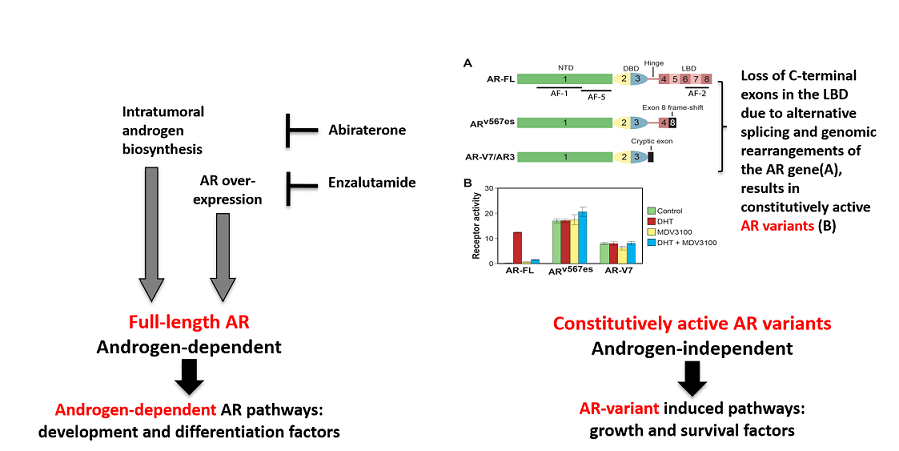Prostate Cancer
Targeting the Aberrant Androgen Receptor in Advanced Treatment-Resistant Prostate Cancer
First feature in a 3-part series focusing on clinical advancements in personalizing AR-targeted therapy



Posted February 8, 2018
Stephen Plymate, Ph.D., University of Washington
Yi Yin, Ph.D., University of Texas Southwestern
The androgen receptor (AR) is an essential therapeutic target for prostate cancer and continues to be a driver of castration resistant prostate cancer (CRPC), the aggressive form of the disease, after standard androgen deprivation therapy with a GnRH agonist or surgical castration. Second generation AR-targeting drugs, abiraterone (Abi) and enzalutamide (Enz), work by targeting the ligand binding domain of AR (Enz) or inhibiting androgen synthesis (Abi) subsequently inhibiting AR signaling. In spite of the effectiveness of these treatments in the short-term, the tumors become resistant and resume growth through continuous AR signaling. Dr. Stephen Plymate of the University of Washington/Seattle VA Health Care System and others had previously shown a novel way this resistance can occur through the development of constitutively active AR-splice variants (AR-Vs), which lose the ligand binding domain of AR yet continue to signal through androgen response elements on chromatin and stimulate growth. New information about the mechanisms of action of AR-Vs and agents targeting their activity are urgently needed.

With funding from a FY12 Transformative Impact Award, Dr. Plymate assembled an international consortium comprising of key leaders in the field of AR signaling including Dr. Johann de Bono at the Royal Marsden Foundation Trust Institute of Cancer Research, Dr. Ganesh Raj at the University of Texas Southwestern, Dr. Scott Dehm at the University of Minnesota, Dr. Elahe Mostaghel at the Fred Hutchinson Cancer Center, and Dr. Wayne Tilley at the University of Adelaide. The ultimate goal of this team-based award was to elucidate mechanisms of response and resistance to current AR targeted therapies in order to identify new approaches for targeted therapeutics.
As part of this program, the investigators evaluated new monoclonal antibodies to detect AR-V7 and AR-V567es in clinical tissues and demonstrated that AR-V7 protein expression was significantly increased in up to 80% of metastatic biopsies following castration and the levels increased further as resistance to Abi and Enz occurred, while levels of full length AR did not. Additionally, expression of AR-V7 was associated with a significant overall decrease in time of survival. By examining the ARv567es splice variant, they found that it is produced by structural rearrangements of the AR gene with subsequent aberrant splicing, which is not seen with the AR-V7 splice variant. These antibodies are now commercially available. By looking at the mechanism by which AR variants go from inactive to their constitutively active forms, they were able to identify a novel constitutively active AR-V, called ARv5es, which had previously been uncharacterized.
To develop new targeted therapies, the group sought to identify proteins that interact with AR variants. Knowing that the HSP90 chaperone protein can activate full length AR, but is not required for AR-V7 activation, the investigators treated AR inhibitor-resistant cells with an HSP90 inhibitor. Their results demonstrated for the first time that HSP90 inhibition leads to the depletion of AR-V7 protein and that HSP90 may play an additional role in AR gene splicing, suggesting that HSP90 inhibition remains a viable approach to blocking AR-V7 in CRPC. Onalespib (AT13387) and other HSP90 inhibitors are now being tested in clinical trials, including a Phase I study of onalespib in combination with Abi in patients with CRPC.
The investigators also optimized a powerful method, rapid immunoprecipitation mass spectrometry of endogenous proteins (RIME), to further characterize additional binding partners of AR-FL and AR-V567es . By labeling the samples with tandem mass tags (TMT), they identified a novel AR variant-interacting protein called GRHL2, which they found to be essential for maintaining AR expression, as well as acting as a classic AR co-regulator to enhance the androgen regulated signaling and cell growth. They found that GRHL2 is frequently amplified and upregulated in CRPC patient samples, potentially enabling it to further amplify AR signaling in the drug-resistant setting, and serves as a potential novel therapeutic target for CRPC.
Parallel work funded by a FY14 Exploration-Hypothesis Development Award to Dr. Yi Yin at the University of Texas Southwestern also identified another role for AR-Vv567es in DNA repair following radiation through binding to a DNA repair gene called DNA-PKc. Drs. Yin, Dehm and Raj's research teams showed that DNA-PKc is critical for these DNA repair mechanisms following radiotherapy and that the combined blockade of AR and DNA-PKc enhances irradiation-mediated cell kill, regardless of whether the prostate cancer cell expresses full length AR, AR-Vv567es, or both. These data establish the importance of DNA-PKc in irradiation-mediated DNA damage response and establish the rationale for a potential clinical trial combining drugs targeting AR and DNA-PKc in combination with radiotherapy for patients with clinically localized prostate cancer.
Finally, Dr. Plymate's lab, in collaboration with Drs. Cato and Myles Brown at Dana Farber Cancer Institute, has defined the cistrome generated by the heterodimerization of full length AR and AR-V7. Using antibodies specific for AR-V7 or full-length AR they demonstrated in the absence of androgen ligands that the heterodimer bound to ARE chromatin binding sites and generates a distinct transcriptome.
This compendium of work has led to a deeper understanding of the mechanisms of AR variant signaling and the discovery of a novel AR-variant, AR-V567es. Through these collaborative studies, several novel binding partners for AR variants have been discovered, including HSP90, GRHL2, and DNA-PKc. Importantly, these novel targets provide therapeutic implications for the treatment of CRPC patients who are resistance to current AR-targeted therapies.

Following castration of men with recurrent prostate cancer, the disease continues to be driven by the full-length Androgen Receptor (AR) due to intratumoral production of androgens. However, once these are blocked by abiraterone or enzalutamide, the AR loses its ligand binding domain (A) and forms a constitutively active AR that drives the tumor in the absence of ligand and is resistant to all current AR-directed therapies.
Publications:
Welti J, Rodrigues DN, Sharp A, et al. 2016. Analytical validation and clinical qualification of a new immunohistochemical assay for androgen receptor splice Variant-7 protein expression in metastatic castration-resistant prostate. Eur Urol 70(4):599-608
Henzier C, Li Y, Yang R, et al. 2016. Truncation and constitutive activation of the androgen receptor by diverse genomic rearrangements in prostate cancer. Nat Commun 7:13668.
Uo T, Dvinge H, Sprenger CC, et al. 2017. Systematic and functional characterization of novel androgen receptor variants arising from alternative splicing in the ligand-binding domain. Oncogene 36(10):1440-1450.
Paltoglou S, Das R, Townley SL, et al. 2017. Novel Androgen Receptor Coregulator GRHL2 Exerts Both Oncogenic and Antimetastatic Functions in Prostate Cancer. Cancer Res. 77(13):3417-3430.
Ferraldeschi R, Welti J, Powers MV, et al. 2016. Second-Generation HSP90 Inhibitor Onalespib Blocks mRNA Splicing of Androgen Receptor Variant 7 in Prostate Cancer Cells. Cancer Res. 76(9):2731-42.
Yin Y, Li R, Xu K, et al. 2017. Androgen Receptor Variants Mediate DNA Repair after Prostate Cancer Irradiation. Cancer Res. 77(18):4745-4754.
Luo J, Attard G, Balk SP, et al. 2017. Role of Androgen Receptor Variants in Prostate Cancer: Report from the 2017 Mission Androgen Receptor Variants Meeting. Eur Urol. [Epub ahead of print]
Links:
Targeting the Aberrant Androgen Receptor in Advanced Treatment-Resistant Prostate Cancer
Role of Alternative Spliced Androgen Receptor in the Radiation Response of Prostate Cancer
Last updated Monday, March 10, 2025














